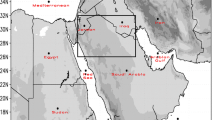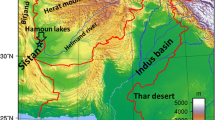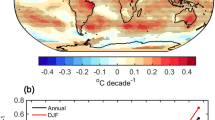Abstract
The synoptic and dynamic characteristics of dust storm events over northern Saudi Arabia were studied during the spring season from 1978 to 2008 using surface dust storm observations from 11 stations and meteorological data from the NCEP/NCAR reanalysis dataset. Two-day dust-free periods were selected before and after each event to represent the pre- and post-event stages, respectively. The synoptic study identified two synoptic systems associated with dust events, i.e., frontal systems and shamal systems, and these systems were associated with increases in the pressure and temperature gradient over the northern Arabian Peninsula (AP) and an eastward shift in the maximum wind as a dust storm event progressed from the pre- to post-event stages. The dynamic study also showed that during the pre-event stage, the atmosphere was baroclinic and featured dynamic disturbances by frontal systems. Additionally, frontal systems resulted in slightly greater intensification than the shamal systems. Moreover, the dynamic study demonstrated that the kinetic energy (KE) shifted eastward and the available potential energy (APE) shifted northward through a series of regions importing and exporting KE and APE. The vertical profile of the average energy area indicated that the main layer in which sensible heat was converted into KE was located above the dust cloud.







Similar content being viewed by others
References
Abdel Wahab M, Abdel Basset H (2000) Energy exchanges for Mediterranean weather systems. Meteorog Atmos Phys 73:1–23
Abdel Basset H (2001) Energy conversion of a desert depression. Meteorog Atmos Phys 76:203–222. https://doi.org/10.1007/s007030170030
Al-Jumaily KJ, Ibrahim MK (2013) Analysis of synoptic situation for dust storms in Iraq. Int J Energy Environ 4–5:851–858
Alpert P, Ganor E (1993) A jet stream associated heavy dust storm in the western Mediterranean. J Geophys Res 98(D4):7339–7349
Alpert P, Osetinsky I, Ziv B, Shafir H (2004a) Semi-objective classification for daily synoptic systems: application to the eastern Mediterranean climate change. Int J Climatol 24:1001–1011
Alpert P, Kischa P, Shtivelman A, Krichak SO, Joseph JH (2004b) Vertical distribution of Saharan dust based on 2.5 year model predictions. Atmos Res 70:109–130
Amanollahi J, Kaboodvandpour S, Qhavami S, Mohammadi B (2015) Effect of the temperature variation between Mediterranean Sea and Syrian deserts on the dust storm occurrence in the western half of Iran. Atmos Res 154:116–125
Awad A, Mashat A (2014a) The synoptic patterns associated with spring widespread dusty days in central and eastern Saudi Arabia. Atmos 5(4):889–913
Awad AM, Mashat AS (2014b) Synoptic features associated with dust transition processes from North Africa to Asia. Arab J Geosci 7(6):2451–2467. https://doi.org/10.1007/s12517-013-0923-4
Awad AM, Mashat AWS (2016a) Synoptic characteristics of spring dust days over northern Saudi Arabia. Air Qual Atmos Health 9(1):41–50
Awad AM, Almazroui M (2016b) Climatology of the winter Red Sea Trough. Atmos Res 182(2016):20–29. https://doi.org/10.1016/j.atmosres.2016.07.019
Awad AM, Mashat AWS (2018) Climatology of the autumn Red Sea trough. Theor Appl Climatol. https://doi.org/10.1007/s00704-018-2453-1
Barkan J, Alpert P (2008) Synoptic patterns associated with dusty and non-dusty seasons in the Sahara. Theor Appl Climatol 94:153–162. https://doi.org/10.1007/s00704-007-0354-9
Barkan J, Alpert P (2010) Synoptic analysis of a rare event of Saharan dust reaching the Arctic region. Weather 65:208–211
De Vries AJ, Tyrlis E, Edry D, Krichak SO, Steil B, Lelieveld J (2013) Extreme precipitation events in the Middle East: dynamics of the active Red Sea trough. J Geophys Res Atmos 118:7087–7108. https://doi.org/10.1002/jgrd.50569
Duce RA (1995) Sources, distributions and fluxes of mineral aerosols and their relationship to climate. In: Charlson RJ, Heintzenberg JJ (eds) Aerosol forcing and climate, pp 43–72
Danard MB (1966) On the contribution of released latent heat to changes in available potential energy. Ibid. 5:81–84
Engelstaedter S, Tegen I, Washington R (2006) North African dust emissions and transport. Earth Sci Rev 79:73–100
Ganor E, Stupp A, Osetinsky I, Alpert P (2010) Synoptic classification of lower troposphere profiles for dust days. J Geophys Res 115:1–8
Gates WL (1961) Static stability in the atmosphere. JMeteor 18:526–533
Ginoux P, Prospero JM, Torres O, Chin M (2004) Long-term simulation of global dust distribution with the GOCART model: correlation with North Atlantic oscillation. Environ Model Softw 19:113–128
Ginoux P, Prospero JM, Gill TE, Hsu NC, Zhao M (2012) Global-scale attribution of anthropogenic and natural dust sources and their emission rates based on MODIS Deep Blue aerosol products. Rev Geophys 50:RG3005. https://doi.org/10.1029/2012RG000388
Gkikas A, Houssos EE, Hatzianastassiou N, Papadimas CD, Bartzokas A (2012) Synoptic conditions favouring the occurrence of aerosol episodes over the broader Mediterranean basin. Q JRoy Meteorol Soc 138:932–949
Goudie A, Middleton N (2006) Desert dust in the global system. Springer, Heidelberg
Hamidi M, Kavianpour MR, Shao Y (2013) Synoptic analysis of dust storms in the Middle East. Asia-Pac J Atmos Sci 49:279–286
Hamidi M (2019) Atmospheric investigation of frontal dust storms in southwest Asia. Asia-Pacific J Atmos Sci 55:177. https://doi.org/10.1007/s13143-018-0083-2
Hannachi A, Awad A, Ammar K (2011) Climatology and classification of spring Saharan cyclone tracks. ClimDyn 37:473–491
Houssos EE, Chronis T, Fotiadi A, Hossain F (2015) Atmospheric circulation characteristics favoring dust outbreaks over the Solar Village, Central Saudi Arabia. Mon Weather Rev 143:3263–3275
Hsu NC, Herman JR, Torres O, Holben BN, Tanre D, Eck TF, Smirnov A, Chatenet B, Lavenu F (1999) Comparisons of the TOMS aerosol index with Sunphotometer aerosol optical thickness: results and applications. J Geophys Res 104:6269–6279
Kalnay E, Kanamitsu M, Kistler R, Collins W, Deaven D, Gandin L ,IridellM, Saha S, White G, WoollenJ,Zhu Y ,Chelliah M, Ebisuzaki W, Higgins W ,JanowiakJ,Mo KC, Ropolewski C, Wang J, Leetma A, Reynolds R, Jenne R, Joseph D (1996) The NCEP/NCAR 40-year Reanalysis project. Bull Am MeteorolSoc 77:437–471
Karyampudi VM, Palm SP, Reagen JA, Hui F, Grant WB, Hoff RM, Mouline HR, Pierce HF, Torres O, Browell ED, Melfi SH (1999) Validation of the Saharan dust plume conceptual model using lidar, Meteosat, and ECMWF data. Bull Am Meteorol Soc 80:1045–1075
Kaskaoutis DG, Kambezidis HD, Nastos PT, Kosmopoulos PG (2008) Study on an intense dust storm over Greece. Atmos Environ 42(29):6884–6896
Kaskaoutis DG, Houssos EE, Rashki A, Francois P, Legrand M, Goto D, Bartzokas A, Kambezidis HD, Takemura T (2016) The Caspian Sea – Hindu Kush index (CasHKI): a regulatory factor for dust activity over Southwest Asia. Glob Planet Chang 137:10–23
Kaskaoutis DG, Rashki A, Houssos EE, Legrand M, Francois P, Bartzokas A, Kambezidis HD, Dumka UC, Goto D, Takemura T (2017) Assessment of changes in atmospheric dynamics and dust activity over Southwest Asia using the Caspian Sea– Hindu Kush index. Int J Climatol 37(Suppl.1):1013–1034
Kishcha P, Alpert P, Barkan J, Kirchner I, Machenhauer B (2003) Atmospheric response to Saharan dust deduced from ECMWF reanalysis (ERA) temperature increments. Tellus B 55:901–913
Kistler R, Collins W, Saha S, White G, Woollen J, Kalnay E, Chelliah M, Ebisuzaki W, Kanamitsu M, Kousky V, vandenDool H, Jenne R, Fiorino M (2001) The NCEP/NCAR 50-year Reanalyses: Monthly CD-ROM and documentation. Bull Am MeteorolSoc 82: 247–267
Kung EC (1966) Kinetic energy generationand dissipation in the large-scale atmospheric circulation. Mon Weather Rev 94(2):67–82
Kung EC, Baker WE (1975) Energy transformations in middle latitudes. Q J Roy Meteorol Soc 101:793–815
Lorenz EN (1955) Available potential energy and the maintenance of the general circulation. Tellus 7:157–167
Margules M (1903) Ober die Energie der St.iirme. Jahrb. Zentrahnst. Meterol. 1–26. (Translation by C. Abbe (1910) in Smithaonian Institute Miscellaneowr Collection 51, 553-595.)
Mashat A, Awad AM (2010) The classification of the dusty areas over the Middle-East. Bull FacSci, Cairo Univ 78(A):1–19
Middleton NJ (1986) Dust storms in the Middle East. J Arid Environ 10:83–96
Mohalfi S, Bedi HS, Krishnamurti TN, Cocke SD (1998) Impact of shortwave effects on the summer season heat low over Saudi Arabia. Mon Weather Rev 126:3153–3168
Nasrallah HA, Nieplova E, Ramadan E (2004) Warm season extreme temperature events in Kuwait. J Arid Environ 56:357–371
Natsagdory L, Jugder D, Chung YS (2003) Analysis of dust storms observed in Mongolia during 1937–1999. Atmos Environ 37:1401–1411
Notaro M, Alkolibi F, Fadda E, Bakhrjy F (2013) Trajectory analysis of Saudi Arabian dust storms. J Geophys Res Atmos 118:6028–6043. https://doi.org/10.1002/jgrd.50346
Pease PP, Tchakerian VP, Tindale NW (1998) Aerosols over the Arabian Sea: geochemistry and source areas for aeolian desert dust. J Arid Environ 39:477–496
Prakash PJ, Stenchikov G, Kalenderski S, Osipov S, Bangalath H (2015) The impact of dust storms on the Arabian Peninsula and the Red Sea. Atmos Chem Phys 15(1):199–222. https://doi.org/10.5194/acp-15-199-2015
Prezerakos NG, Michaclides SC (1989) A composite diagnosis in sigma coordinates of the atmospheric energy balance during intense cyclonic activity. Quart J Roy Meteor Soc 115:463–486
Prospero JM (1996) In: Guerzoni S, Chester R (eds) Saharan dust transport over the North Atlantic Ocean and Mediterranean: an overview, in The impact of desert dust across the Mediterranean. Kluwer Acad., Norwell, pp 133–151
Prospero JM, Ginoux P, Torres O, Nicholson SE, Gill TE (2002) Environmental characterization of global sources of atmospheric soil dust identified with the Nimbus 7 Total Ozone Mapping Spectrometer (TOMS) absorbing aerosol product. Rev Geophys 40:1002. https://doi.org/10.1029/2000RG000095
Raispour K, Khosravi M, Tavousi T, Sharifikiya M (2014) The influence of the polar front jet stream on the formation of dust events in the southwest of Iran. AirQualAtmos Health 9:15–23. https://doi.org/10.1007/s11869-014-0270-y
Raju PVS, Bhatla R, Mohanty UC (2011) A study on certain aspects of kinetic energy associated with western disturbances over Northwest India. Atmósfera 24(4):375–384
Rashki A, Kaskaoutis DG, Rautenbach CJW, Flamant C, Abdi VF (2014) Spatio-temporal variability of dust aerosols over the Sistan region in Iran based on satellite observations. Nat Hazards 71:563–585
Raziei T, Mofidi A, Santos AJ, Bordi I (2012) Spatial patterns and regimes of daily precipitation in Iran in relation to large-scale atmospheric circulation. Int J Climatol 32:1226–1237
Qian W, Quan L, Shi S (2002) Variability of the dust storm in China and its climatic control. J Clim 15:1216–1229
Shalaby A, Rappenglueck B, Eltahir EAB (2015) The climatology of dust aerosol over the Arabian Peninsula. Atmospher Chem Phys Dis 15(2):1523–1571
Chen T-C, Lee Y-H (1983) A study of the kinetic energy generation with general circulation model. J Meteor Soc 61:439–448
Smirnov A, Holben BN, Dubovic O, O’Neill NT, Eck TF, Westphal DL, Goroth AK, Pietras C, Slutsker I (2002) Atmospheric aerosol optical properties in the Persian Gulf. J Atmos Sci 59:620–634
Smith PJ (1969) On the contribution of a limited region to the global energy budget. Tellus 21:202–207
Smith PJ, Horn LH (1969) A computational study of the energetics of a limited region of the atmosphere. Tellus 21:193–201
Smith PJ (1980) The energetics of extratropical cyclones. Rev Geophys 18:378–386
Vishkaee FA, Flamant C, Cuesta J et al (2011) Multiplatform observations of dust vertical distributionduring transport over Northwest Iran in the summertime. J Geophys Res 116:D05206. https://doi.org/10.1029/2010JD014573
Washington R, Todd M, Middleton NJ, Goudie AS (2003) Dust-storm source areas determined by the total ozone monitoring spectrometer and surface observations. Ann Assoc Am Geogr 93:297–313. https://doi.org/10.1111/1467-8306.9302003
Washington R, Todd MC (2005) Atmospheric controls on mineral dust emission from the Bodele depression, Chad: the role of the low level jet. Geophys Res Lett 32(17):L17701 ISSN 0094–8276
WMO (2005) Climate and land degradation. Geneva, Switzerland, World Meteorological Organization
Yu Y, Notaro M, Liu Z, Kalashnikova O, Alkolibi F, Fadda E, Bakhrjy F (2013) Assessing temporal and spatial variations in atmospheric dust over Saudi Arabia through satellite, radiometric, and station data. J Geophys Res 118:1–12. https://doi.org/10.1002/2013JD020677
Yu Y, Notaro M, Kalashnikova OV, Garay MJ (2016) Climatology of summer Shamal wind in the Middle East. J Geophys Res-Atmos 121:289–305. https://doi.org/10.1002/2015JD024063
Acknowledgments
The authors thank the DSR for technical and financial support. The authors also acknowledge the National Centers for Environmental Prediction (NCEP) and the National Center for Atmospheric Research (NCAR) for providing meteorological data.
Funding
This study was funded by the Deanship of Scientific Research (DSR) at King Abdulaziz University, under grant no. G: 165-155-1439.
Author information
Authors and Affiliations
Corresponding author
Ethics declarations
Conflict of interest
The authors declare that they have no conflict of interest.
Additional information
Publisher’s note
Springer Nature remains neutral with regard to jurisdictional claims in published maps and institutional affiliations.
Rights and permissions
About this article
Cite this article
Mashat, AW.S., Awad, A.M., Assiri, M.E. et al. Dynamic and synoptic study of spring dust storms over northern Saudi Arabia. Theor Appl Climatol 140, 619–634 (2020). https://doi.org/10.1007/s00704-020-03095-6
Received:
Accepted:
Published:
Issue Date:
DOI: https://doi.org/10.1007/s00704-020-03095-6




